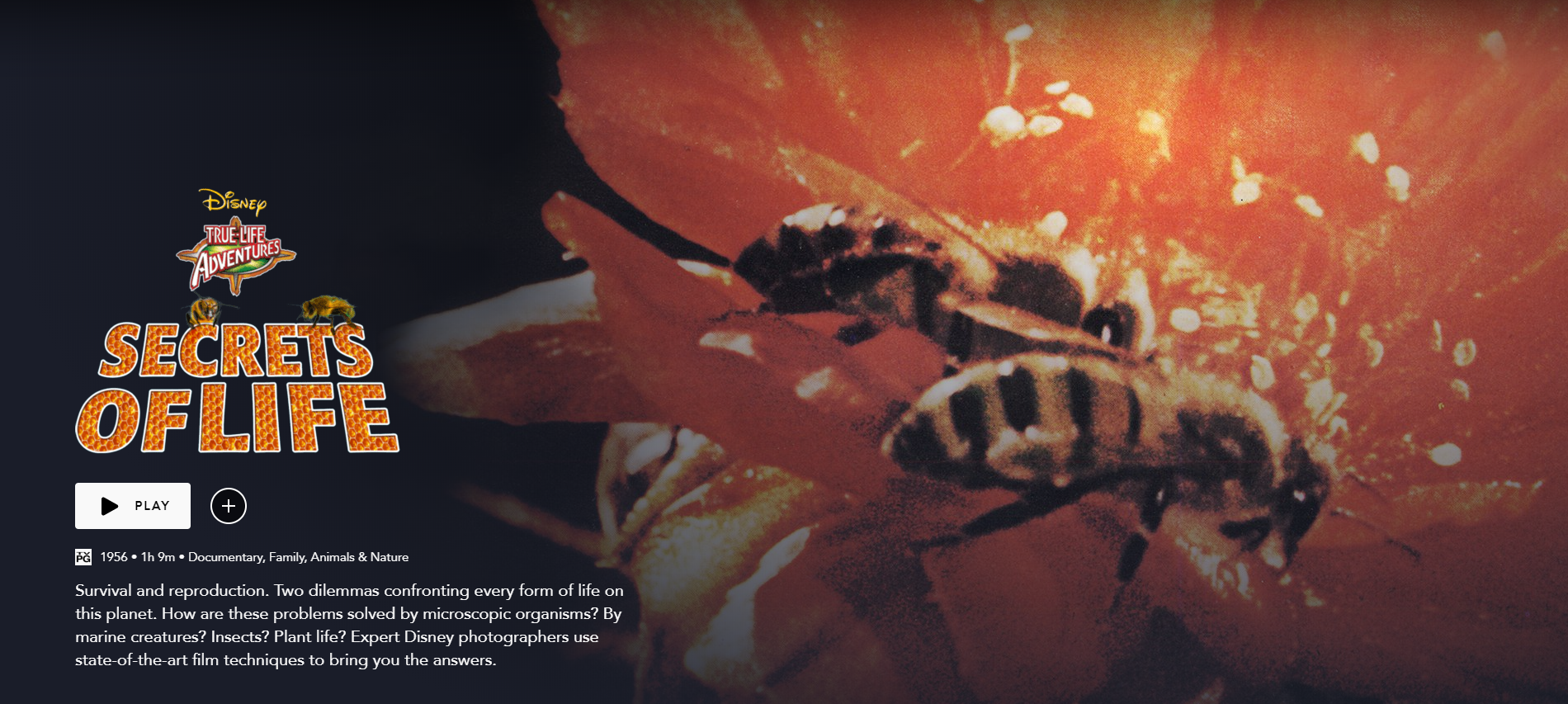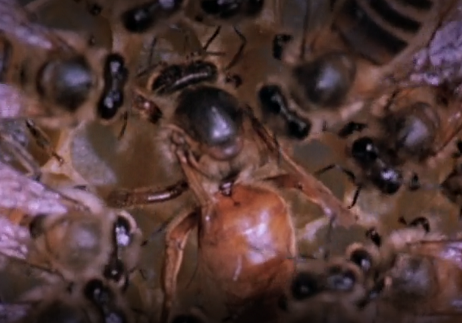Review: Secrets of Life (DMC #24)
Happy Friday, Disnerds! Last night we watched the 24th movie in the Disnerd Movie Challenge, Secrets of Life. If you watched with us last night, feel free to skip over our synopsis and jump straight to our review.
Synopsis
Life on Earth is a constant battle, and all of nature is in a constant state of development. As nature has changed over billions of yeas, so too has life had to change with it. Earth provides both protection and destruction to its species, and these constant processes force the planet’s lifeforms to adapt if they are to survive. The plants surrounding the earth are a key source of life, for they contain seeds which cause new flora to bloom. Some of these seeds can be carried by the wind, such as the cottonwood. Others, like the wild oat, are self-sowing. In the strangest of cases, some seeds will only blossom at the touch of a forest fire, which serves a purpose in nature’s story despite its destruction. At the peak of their growth some of them may sprout fruit or vegetables. To continue living, many of the plants rely on bees to carry their pollen and spread it across the land. The bees will also collect nectar from the flowers, used to make honey.
Ants rival bees with their own honey-making, and surpass them in their industrial skills. Each member has a special skill suited to keeping the colony alive. These tiny creatures work together in harmony to protect their home from pests, including termites and blister beetles. Their strength is such that they can lift rocks many times their size, a skill they use to construct complex underground tunnels for their homes. Moving away from the land species, nature has provided for underwater creatures. The stickleback fish seems to have defined goals and purposes, with the male creating a home for its future young and the female providing said young. Anglerfish use their namesake appendage to lure unsuspecting prey, while male fiddler crabs try to entice female mates. The various creatures of the world have adapted to new forms survival and reproduction, changing right along with the planet. The last example we are shown is the volcano, one of the most powerful ways Earth changes itself. With the destruction of its own land, new earth is eventually formed.
Thoughts Before Watching
Megan: Not another True Life Adventure documentary! I’m sorry, but I am not looking forward to this one. Maybe it’s the style of these documentaries, maybe it’s that I know most of this information already, but either way I’m finding them to be pretty boring. On the plus side, it’s not Old Yeller, which I’m dreading having to watch again in a few weeks… Also, is anyone else a little worried that this Disney documentary is going to address “the birds and the bees”? Like…how far are we going to go with these secrets of life in a PG film?
Kevin: Oh, man…. not looking forward to Old Yeller. Looking forward in our calendar, it looks like we won’t have a film we’ll truly enjoy until next month when we watch Sleeping Beauty. Well, until then, we will continue to work through these less exciting films. We haven’t rated these True Life Adventures series very high, and I’m not anticipating that will change with this one. On the other hand, we move away from mammals and into the realm of insects so maybe this will change things up a bit?
Thoughts After Watching
YAWN!
Megan: Apparently it is possible for this film to be even more boring than the previous True Life Adventure films. Kevin and I both were yawning through this one. First off, it starts with a snooze-fest sequence of plants growing or otherwise moving, their slow movements sped up with camera effects. I wouldn’t mind one or two of these shots, but so many of these go on for far too long, and, to be honest, I knew a lot of this stuff already. Maybe not how some seeds have “legs” or corkscrew themselves into the ground to plant themselves, but the rest of it, yes. The segment on bees is mildly interesting, but the ants, protozoans, fish, and crabs just don’t hold my interest. And what’s with that lava sequence at the end? It feels totally out of place, and, having seen documentaries on volcanoes before, the multiple shots of lava flowing with limited narration is just dull.
I think part of the struggle here is also in the premise. It appears that the theme was meant to be how nature perpetuates new life, yet in order to keep a PG rating I’m sure they weren’t allowed to visually show animals mating. Rather than “the birds and the bees” this documentary focuses on…well…the bees. And the plants. And the fish. This limits the conversation to animals that quite frankly aren’t cute. If we got to see baby mammals that might have added a bit more interest for me, but given the style of these documentaries, I’m not sure even the cutest baby animal would have saved this film.
Kevin: How do I even begin with this? C’mon, Disney—you can do better than this. I’m sorry to any of you who found this interesting and won’t like that we’re heavily critical of it. There’s just very little here that’s actually new or interesting. We’ve seen this persistent theme of nature throughout the True Live Adventures series. In each of them, the narrator says over and over that nature protects its life, and nature provides adaptation, and nature is a a cycle, and nature this and nature that. The message has just been repeated so often it gets annoying, even though I realize there’s not much else you can do with these films. I also think it’s strange how the film avoided mating scenes, yet the studio was okay with showing animal corpses in The African Lion.
I’ll give this movie a little bit of redemption, and it’s the sped up camera work used on the flowers, as well as the explanation of how honey is made. I was most interested in watching the flowers grow at a quick pace, and seeing them bloom. And while I knew the basics of how honey is formed, I hadn’t seen it on screen before, so it was just mildly cool to watch it unfold here. I give the filmmakers credit for being able to film that close to a beehive.
Again with the sexist narration…
Megan: I know that some elements of nature are somewhat inherently sexist by design, but the narration takes things a step further. Rather than merely making observations, the narration inserts additional sexist commentary. For example, when introducing the queen bee, the narrator says “the queen is slave to her destiny as the sole reproducer.” Why use the word “slave” here? Especially when we learn later on that the newly hatched queen bee is the only bee who doesn’t lose her stinger, and she uses it to kill off the competitor queens in order to win the role of sole reproducer. That is one tough queen bee! When a hive cannot survive without a queen, and a queen bee is so tough, why diminish her importance by basically reducing her to a sex slave in her introduction? It’s subtle—just a single word—yet it’s just the first of many sexist remarks. Even the male bees don’t fare much better under this narration, as the drones are labeled as “lazy,” further perpetuating this idea that it is acceptable, or even expected, that males will be lazy.
When we get to the fish segment of the documentary, the narrator notes that “as a rule, father provides, mother protects.” That’s fine, I guess, since in nature that does tend to be the case, with mothers guarding their young while fathers go out in search of food. However, as the narrator begins describing the stickleback fish, which is an exception to this “rule,” the sexism creeps back in. The very nature of the stickleback male being the one who builds the nest and tends to the young is seen as unusual, as if the only reason we’re paying any attention to it is because it flips our society’s ideas of gender roles. If the society of the 1950s had been one where it was commonplace for men to be stay-at-home dads and women to be breadwinners, the stickleback wouldn’t be seen as unusual at all. It is only through the lens of a patriarchal society, where women are “supposed to” stay home and only take care of the kids while the men go off to work, that the stickleback becomes unusual and therefore interesting.
I could go on with how the female fiddler crab is described as pretending to ignore the males’ advances because she’s “feminine” or how the stickleback house-building “conversation” does a disservice to both genders, but it all comes back to the same thing. The male point of view here adds a sexist veil to the narration, which in turn influences how we view this documentary. And like all the other True Life Adventures documentaries, this also fails the Bechdel test.
Kevin: I agree that lazy male sounds like the expectation, especially in older films. These documentaries have made several jokes about this before, and each time it sounds less of a criticism and more of an obvious fact of life that can’t be changed. Again, this is nature, and animals will abide by their instincts, but what do these messages say about roles within human society? It’s not hard to believe that the filmmakers weren’t looking to challenge the status quo of female nurturer and male provider. Nor should they challenge it, as a documentary is about facts. However, as Megan points out above, the word choice here is rather strange.
Kevin: As I said earlier, we haven’t favored these documentary films. In fact, they’re as bad as the war-era package films, if not worse. I’ve noticed, however, that all of the True Life Adventures films have high ratings according to various sources, so they’re clearly resonating with some people. I think this is just not the kind of thing Megan and I enjoy, at least not this style of documentary. While don’t care much for them, I hope you get some entertainment value out of them.


